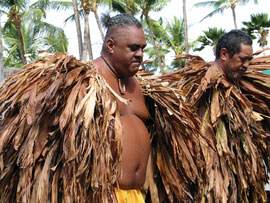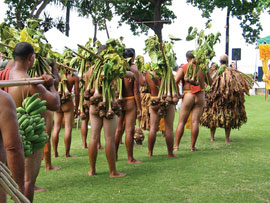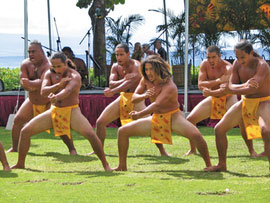 Makahiki marked an astonishing change in the normal fabric of life. Commoners and chiefs alike abstained for at least half of every eight-day period from fishing and farming; and ceremonies honoring Lono, the god of fertility and agriculture, dominated religious activities. David Malo described the earnestness and sincerity with which the common people prayed for health and prosperity for themselves and their chiefs; and how the ali‘i (royalty) joined them in prayers for the ‘aina’s (land’s) vitality.
Makahiki marked an astonishing change in the normal fabric of life. Commoners and chiefs alike abstained for at least half of every eight-day period from fishing and farming; and ceremonies honoring Lono, the god of fertility and agriculture, dominated religious activities. David Malo described the earnestness and sincerity with which the common people prayed for health and prosperity for themselves and their chiefs; and how the ali‘i (royalty) joined them in prayers for the ‘aina’s (land’s) vitality.
Those prayers were directed towards the akua loa, a 12-foot-high wooden image of the god Lono. Adorned with white kapa, feathers and foliage, Lono circled the islands, the ocean to his left; to his right, the upland forest realm of Ku, the god of war. The journey symbolized the respite from Ku’s world of strife and the ascendance of Lono’s realm of agriculture, healing, and peace. Ho‘okupu (offerings) of sweet potatoes, gourds, medicinal plants, pigs, and handicrafts were collected within each ahupua‘a (land district) to entreat the gods—and their representatives, the ali‘i—to preserve the relationship among god, man and ‘aina. When the mo‘o Lono (priests of Lono) arrived, prayers were chanted that made the land noa, free of its normal taboos.
 Throughout Makahiki, while the god Ku rested, while Lono ruled and softened the lands with rain, an ironclad kapu forbade war. To keep their skills honed in a time of peace, warriors vied in the games of Makahiki that were a source of pride for ali‘i and maka‘ainana (subjects) alike. Engravings by early European visitors show the throngs that gathered to witness their champions compete in events ranging from mokomoko (Hawaiian boxing), to heihei (foot races), ‘¯o‘¯o ihe (spear throwing); and traditional games like maika, a form of outdoor bowling that aimed a cylindrical stone between two pegs. Events requiring wit, oratory, artistry, and spiritual knowledge played a part, such as nane (riddle contests), hula, and haku mele (composition of chants).
Throughout Makahiki, while the god Ku rested, while Lono ruled and softened the lands with rain, an ironclad kapu forbade war. To keep their skills honed in a time of peace, warriors vied in the games of Makahiki that were a source of pride for ali‘i and maka‘ainana (subjects) alike. Engravings by early European visitors show the throngs that gathered to witness their champions compete in events ranging from mokomoko (Hawaiian boxing), to heihei (foot races), ‘¯o‘¯o ihe (spear throwing); and traditional games like maika, a form of outdoor bowling that aimed a cylindrical stone between two pegs. Events requiring wit, oratory, artistry, and spiritual knowledge played a part, such as nane (riddle contests), hula, and haku mele (composition of chants).
After four months, the god Ku rose once again to rule over kau wela, the hot summer season. A canoe with offerings to Lono was set adrift to help return him to his ancestral lands and petition his generosity for the following year, and Makahiki concluded.
 Within decades of European contact, the celebration of Makahiki began to disappear. Hokulani Holt-Padilla, cultural advisor for the Maui Arts & Cultural Center, suggests that it began to wane during the ‘ai noa period, when taboos such as the ban on men and women eating together were lifted, eroding the Hawaiian belief system. By the 19th century, Christianity had begun to supplant Hawai‘i’s pantheon of gods and goddesses, and with it, the worship of Lono at the heart of Makahiki. Cultural practitioner Lyons Naone recalls, “I was married to a strong Catholic, and she wouldn’t allow the kids to be taken to such a ceremony. We couldn’t do games or witness protocols, since the clergy frowned on it.” Naone remembers many decades when only sporadic, subtle recognitions of Makahiki survived, along with offerings in secluded spots such as Kipahulu.
Within decades of European contact, the celebration of Makahiki began to disappear. Hokulani Holt-Padilla, cultural advisor for the Maui Arts & Cultural Center, suggests that it began to wane during the ‘ai noa period, when taboos such as the ban on men and women eating together were lifted, eroding the Hawaiian belief system. By the 19th century, Christianity had begun to supplant Hawai‘i’s pantheon of gods and goddesses, and with it, the worship of Lono at the heart of Makahiki. Cultural practitioner Lyons Naone recalls, “I was married to a strong Catholic, and she wouldn’t allow the kids to be taken to such a ceremony. We couldn’t do games or witness protocols, since the clergy frowned on it.” Naone remembers many decades when only sporadic, subtle recognitions of Makahiki survived, along with offerings in secluded spots such as Kipahulu.





